Join us for conversations that inspire, recognize, and encourage innovation and best practices in the education profession.
Available on Apple Podcasts, Spotify, Google Podcasts, and more.

The TerrAqua Column (see building instructions below) is a bottle system that is composed of terrestrial and aquatic habitats. The terrestrial habitat, or terrarium, houses organisms in soil and above-ground subhabitats. The aquatic habitat, or aquarium, houses floating and submerged organisms, as well as organisms that live on top of or in aquatic sediments. The terrarium and the aquarium are connected to one another through water — the terrarium drains into the aquarium, which, in turn, provides the terrarium with water that is drawn through a wick that runs between the two.
The Life Science TerrAqua Column is designed as a companion to the videos for Session 1 (“What Is Life?”) and Session 2 (“Classifying Living Things”). This system provides opportunities for learning about the characteristics of life by observing living things in their environments over time. It is also well suited for activities that involve distinguishing between organisms based on habitat, the roles they play, or the features that classify them as plants, animals, or other life forms.
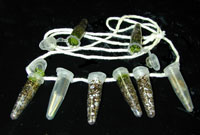
Get a Life Necklace
Life Science suggests several activities for the TerrAqua Column that are excellent introductions to a scientific study of the living world. “Get a Life!” features the “necklace” worn in the video by Bottle Biology creator Paul Williams. In this activity, the challenge is to test whether an object is alive by creating life-sustaining conditions in small tubes that can be worn around the neck.
“Taking Inventory” emphasizes careful description of the living things that are introduced into the system, while “Pondering Change” allows you to keep track of changes in the system over time. “Is It Alive?” parallels an activity seen in Session 1 in LauraJo Kelly’s second-grade classroom where items are classified as living, dead, or nonliving.
The fascinating world of microbes is made visible with “Now You See It.” “What Is It?” provides a systematic approach to classifying living things into the groups that scientists use to organize the living world.
You can follow along online and track your progress with “Is It Alive?” “Now You See It,” and “What Is It?”
For more background information and additional activity ideas, you can visit the Bottle Biology website at www.bottlebiology.org.
The most basic TerrAqua Column combines a deep base unit with deep funnel and top units. We added an internal unit to the aquarium in our Essential Science for Teachers TerrAqua Column to provide additional viewing and photographing space.
What you stock your TerrAqua Column with involves your goals for study, the sources of your specimens — local or purchased — and your own creativity. The simplest way to stock your Column is to collect from your local environment. Because our goals were to use the TerrAqua Column as a learning tool for the Essential Science for Teachers course, we combined local collections with purchased specimens to make our system particularly diverse.
Depending on the activities you choose to do, you may need one or more of the following:
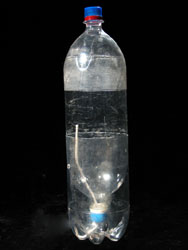 Materials needed
Materials neededFor Building
For Stocking and Maintaining
It’s very important that all materials introduced into the TerrAqua Column — living, dead, or nonliving — are clean and free of anything that might be toxic to living things (e.g., oil, pesticides, etc.). The organisms you introduce should be small and suited to the habitats you construct. The number of organisms you introduce will depend on what they are but it is generally best to err on the side of adding too few than too many, especially in the aquatic habitat. Bigger organisms should definitely be limited to one or two.
You can download an inventory of aquatic and terrestrial plants and animals (PDF) that Paul Williams has found make good choices. Many varieties can be collected from local environments and most can be purchased from Carolina Biological Supply Company (1- 800–334–5551) or www.carolinabiological.com.
The Bottle Biology Web site is also a resource for materials “custom developed” for bottle systems like this.
Aquatic habitat
Terrestrial habitat
Maintenance Instructions

Get a Life Necklace
For Building
Microcentrifuge tubes can be purchased from Carolina Biological Supply Company (1-800-334-5551) or www.carolinabiological.com.
Building Instructions:
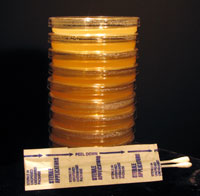 Materials needed For Building
Materials needed For BuildingBoth of the above can be purchased from Carolina Biological Supply Company (1-800–334–5551) or www.carolinabiological.com. Store unused media upside-down in a refrigerator.
Now that you’ve built the components you need for the TerrAqua system, try these activities to further your understanding. First read the instructions and perform the activity. For selected activities, view an example of our results in Track Our Progress.

Get a Life Necklace
How can you tell if an object is living? If it is alive, what conditions are essential for its survival? In “Get a Life!”, you’ll have an opportunity to test your ideas by creating tiny habitats to which you introduce objects that puzzle or interest you. Your habitats are strung together in a necklace so that you’ll be right there to observe what happens!
Before you begin
After the activity
The TerrAqua Column that you’ve designed includes a variety of aquatic and terrestrial organisms. In a study system like this, it’s important to describe the living things that you stock it with before you introduce them into their habitats. “Taking Inventory” will assist you in doing this, and “Pondering Change” will help you predict changes that you think will occur as your TerrAqua Column develops over time.
Taking Inventory
Pondering Change
At the start of your study period
At the end of your study period

Are these dried peas alive?
As a companion to the Essential Science for Teachers course, the TerrAqua Column is meant to help you apply what you learn during Session 1: What Is Life? To do this, a good TerrAqua Column design will include living, dead, and nonliving components — those that you’ve introduced as well as those that are “included” as part of the bottle system (i.e., the bottles and the air). “Is It Alive?” provides you with an opportunity to classify these items as living, dead, and nonliving using what you’ve learned about the characteristics of life.
Before you stock your TerrAqua Column
At the End of Your Study Period
TRACK OUR PROGRESS: Is It Alive?
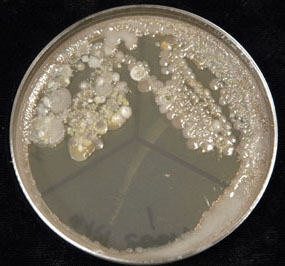
Culture of waterfern (upper left) and moss
(upper right) after seven days
If you could shrink yourself to the size of a microbe, what do you think you’d see in your TerrAqua Column? “Now You See It” helps make the world of microbes observable through cultures that are visible because they’re made of millions — even billions — of individual organisms. This activity uses special materials that support microbial life — Petri plates that contain prepared media, which acts as a food source.
Your cultures will include mostly bacteria and some fungi. Bacteria will generally appear at first as small pinpoint-sized colonies that will grow to become much larger. Two types of fungi may grow. Yeast colonies resemble bacterial colonies, while molds will develop into fuzzy growths. It’s not important that you identify which is which, just that you observe and appreciate what can’t be seen in soil, air, water, and on plants and animals.
Note: It is safe to culture microbes in this way — they grow in a closed container and are types that are already present in the environment. To dispose of the plates, spray with disinfectant solution, seal, and throw away. The only thing to be careful about is opening the plate — each time you do, you may introduce new microbes!
Before you swab your plates
After your study period
TRACK OUR PROGRESS: Now You See It
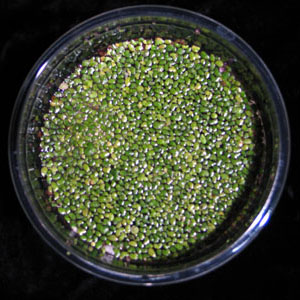
One of the organisms you may identify in “What Is It?”
In Session 2, the focus was on a systematic approach to classifying living things. “What Is It?” is meant to engage you in classifying the organisms in your TerrAqua Column using the strategy for classifying into Domains and Kingdoms that was introduced in the video. In addition, you’ll be able to classify further in the plant and animal kingdoms.
What you’ll be using are “dichotomous keys,” which are used every day by scientists to identify unknown organisms. Dichotomous keys involve “decision points” about an organism, where you have two choices. Each “decision” takes you further in classification. While the organisms in your TerrAqua Column may not be unknown to you, What Is It? will provide good experience in classification.
Get a glimpse of our system at various points in selected activities. Remember that every system is unique: don’t expect yours to look exactly like ours!
Click on one of the pictures below to see an enlargement of the terrestrial or aquatic habitats of our TerrAqua system, then click on any of the question marks on those enlargements to see a close-up of the component being pointed to. See the What Is It? activity instructions for questions to consider, and use the What Is It? Data Sheet (PDF) to classify each component. If you need help, the TerrAqua Column Organisms Information Sheet (PDF) may be useful.
Note: Because our goals were to use the TerrAqua Column as a learning tool for your Essential Science for Teachers course, we combined local collections with purchased specimens to make our system particularly diverse; your components, of course, may differ.